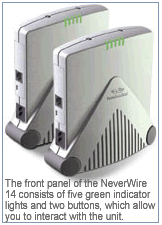If you’re looking to network a non-mobile device like a desktop computer or two, a HomePlug-based power line networking adapter is a logical way to go.
One recent entry into the realm of such adapters is the NeverWire 14 from Phonex Broadband. A powerline-based networking product from a company called “Phonex” might seem odd, but the company originally sold phoneline-based networked devices in the days before 802.11x and now HomePlug rendered them obsolete — or at least less desirable.
The number in the NeverWire 14’s nomenclature refers to the 14 Mbps speed supported by the HomePlug 1.0 standard. While some HomePlug-based products use USB 1.1 as an interface that can bottleneck performance with a 12 Mbps top speed, the NeverWire 14 is an Ethernet-based device, which lets you take full advantage of the available bandwidth plus connect to a hub or switch (as well as use as a stand-alone device).
Give credit to Phonex for recognizing that someone that wants one powerline networking device probably wants two. Phonex shrink-wrap bundles a pair of units together for a list price of $189.99 — a $10 price break off two units purchased separately. Additional individual units cost $99 a piece — up to 16 units can be supported on the same network. (There’s no limit to the number of devices that can connected to a NeverWire 14 via a hub or switch, aside from practical limits of bandwidth.)
The NeverWire 14’s documentation is pretty extensive, going into a reasonable level of detail on how to set up the unit as well as configure the network settings on your respective PCs.
A useful tri-fold Quick Start Guideis also included, and the identical panels of information are replicated in the manual. At first I thought this type of replication was silly, but upon further reflection I think it makes a lot of sense, especially for novices networking users.
Physically, the NeverWire 14 bears a strong resemblance to a cable modem, with its dark grey color and rectangular shape. With a wide base and two rubber feet, it’s designed in such a way that it can be used in either a horizontal or vertical orientation. The unit also provides two holes for wall mounting, but the hardware to do so is not provided.
The NeverWire 14 provides a toggle to switch the Ethernet port between straight-through and crossover mode, obviating the need for a crossover cable. Phonex throws in a straight-through CAT 5 cable as well.
On the subject of cables, one minor complaint is the extremely short length of the power cord. At about three feet, it’s half the customary length and it obviously limits how far from a wall outlet you can place the unit.

I wish some software had been provided, because using the buttons to configure the unit got tedious fairly quickly. Tasks are initiated depending on long a button is pressed and feedback comes in the form of blinking indicator lights. If you’ve ever tried to configure a laser printer using control panel buttons, you know what I’m talking about.
For example, pressing the DIAGS button for “1-2 seconds” enables a unit self test, while pressing it for 7 seconds performs a node test (to confirm connectivity with other units). Similarly, enabling the 56-bit DES security involves holding down the SECURE button for 12 seconds (yes, as in one more than eleven).
It doesn’t help that the buttons tended to be a little squishy, often leaving me in doubt as to whether I had pressed them hard enough, or whether they were still pressed 7 or 12 seconds after I started. On more than one occasion I pressed a button only to find out later that it didn’t “take.”
Bottom line? A Web-based configuration tool or even a Windows-based utility would have been much preferable.
Still, networking computers using NeverWire 14s was not difficult. If you’ve pre-configured your PCs’ Ethernet ports with IP addresses on the same subnet, then you’re pretty much ready to roll once you plug in the NeverWire 14 units into their respective machines.
For the performance testing, I networked two notebook computers together using NeverWire 14 units. Each NeverWire 14 was plugged directly into a wall outlet, as Phonex Broadband says that plugging a NeverWire 14 unit into a surge suppressor will prevent the unit from functioning. The computers were on separate floors and circuits, approximately twenty feet apart (vertically). According to Phonex, the units will operate up to 150 feet apart.
The performance results were more or less on par with expectations, though NeverWire 14 was a bit slower than a comparable Netgear XA601. The NeverWire 14’s TCP throughput was 5.3 Mbps and UDP streaming performance was 465 kbps, with minimal packet loss.
In my opinion, the Phonex NeverWire 14 loses some of its appeal due to the need to manipulate buttons on the units to configure them. In spite of this though, it still delivers solid performance and a reasonable price, making it a worthy pick for networking your non-mobile devices.
Adapted from PracticallyNetworked.com.

